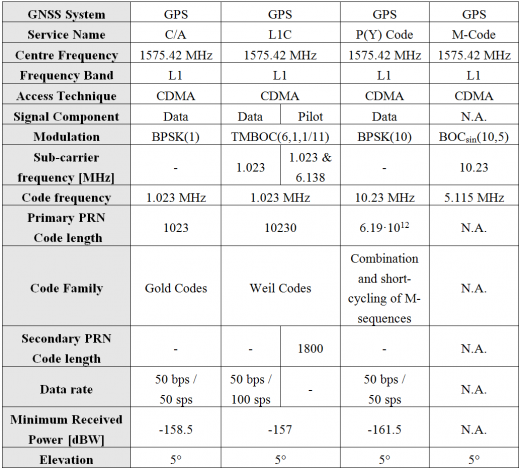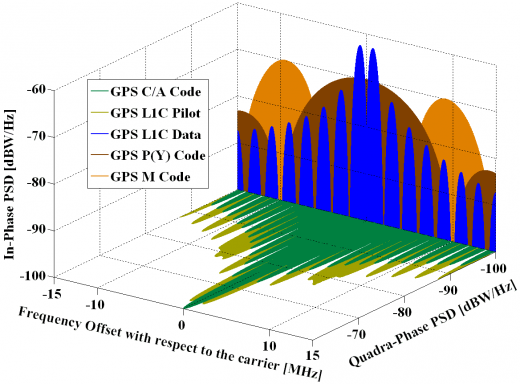If you wish to contribute or participate in the discussions about articles you are invited to contact the Editor
GPS Signal Plan
| Fundamentals | |
|---|---|
| Title | GPS Signal Plan |
| Author(s) | J.A Ávila Rodriguez, University FAF Munich, Germany. |
| Level | Advanced |
| Year of Publication | 2011 |
GPS L1 Band
The GPS L1 band (1575.42 MHz) has turned to be the most important band for navigation purposes. Indeed most of the applications in the world nowadays are based on the signals transmitted at this frequency. As stated in [GPS ICD 200][1], three signals are transmitted at the moment by GPS in L1: C/A Code, P(Y) Code and M-Code. In the future, an additional new civil signal, known as L1C, will also be transmitted. We describe all of them in the next lines:
- The Coarse/Acquisition (C/A) code signal was primarily thought for acquisition of the P (or Y) code and has become nowadays the most important signal for mass market applications. The PRN C/A Code for SV ID number i is a Gold code, [math]\displaystyle{ G_i (t) }[/math], of 1 millisecond in length at a chipping rate of 1.023 Mbps. The [math]\displaystyle{ G_i (t) }[/math] sequence is a linear pattern generated by the Modulo-2 addition of two subsequences, [math]\displaystyle{ G_1 }[/math] and [math]\displaystyle{ G_{1i} }[/math], each of them being a 1023 chip long linear pattern. The epochs of the Gold code are synchronized with the [math]\displaystyle{ X_1 }[/math] epochs of the P-code.
- The P Code is the precision signal and is coded by the precision code. Moreover the Y-Code is used in place of the P-code whenever the Anti-Spoofing (AS) mode of operation is activated as described in the ICDs 203, 224 and 225. The PRN P-code for SV number i is a ranging code, Pi(t), 7 days long at a chipping rate of 10.23 Mbps. The 7 day sequence is the Modulo-2 sum of two sub-sequences referred to as [math]\displaystyle{ X_1 }[/math] and [math]\displaystyle{ X_{2i} }[/math] with 15,345,000 chips and 15,345,037 chips, respectively. The [math]\displaystyle{ X_{2i} }[/math] sequence is an [math]\displaystyle{ X_2 }[/math] sequence selectively delayed by 1 to 37 chips allowing the basic code generation technique to produce a set of 37 mutually exclusive P-code sequences 7 days long.
- The modernized military signal (M-Code) is designed exclusively for military use and is intended to eventually replace the P(Y) code [E. D. Kaplan and C. Hegarty, 2006][2]. The M-Code provides better jamming resistance than the P(Y) signal, primarily through enabling transmission at much higher power without interference with C/A code or P(Y) code receivers [B.C. Barker et al., 2000][3]. Moreover, the M-Code provides more robust signal acquisition than is achieved today, while offering better security in terms of exclusivity, authentication, and confidentiality, along with streamlined key distribution. In other aspects, the M-Code signal provides much better performance than the P(Y) Code and more flexibility.
- The L1 Civil signal (L1C), defined in the [GPS ICD-800, 2006][4], consists of two main components; one denoted [math]\displaystyle{ L1C_P }[/math] to represent the pilot signal, consisting of a time-multiplexing of BOC(1,1) and BOC(6,1), thus without any data message, and [math]\displaystyle{ L1C_D }[/math], with a pure BOC(1,1), for the data channel. This is spread by a ranging code and modulated by a data message. The pilot channel [math]\displaystyle{ L1C_P }[/math] is also modulated by an SV unique overlay secondary code, [math]\displaystyle{ L1C_O }[/math].
For more details on the code generation refer to the [GPS ICD 200] and [GPS ICD-800, 2006]. Finally, the technical characteristics of the existing and planned GPS signals in the L1 band are summarized in the following Table 1.
Of all the signals above, the C/A Code is the best known as most of the receivers that have been built until today are based on it. The C/A Code was open from the very beginning to all users, although until May [math]\displaystyle{ 1^st }[/math], 2000 an artificial degradation was introduced by means of the Select Availability (SA) mechanism which added an intentional distortion to degrade the positioning quality of the signal to non-desired users. As we have already mentioned, the C/A Code was thought to be an aid for the P(Y) Code (to realize a Coarse Acquisition). The M-Code is the last military signal that has been introduced in GPS.
For a long time different signal structures for the M-Code were under consideration [J.W. Betz, 2001] [5]being the Manchester code signals (BPSK) and the binary offset carrier (BOC) signals the two favoured candidates. Both solutions result from the modulation of a non-return to zero (NRZ) pseudo random noise spreading code by a square-wave sub-carrier. While the Manchester code has a spreading code of rate equal to that of the square-wave, the BOC signal does not necessarily have to be so, being the only constraint that the rate of the spreading code must be less than the sub-carrier frequency.
The interesting aspect about these signals is that, like the conventional sub-carrier modulation, the waveform presents a zero at the carrier frequency due to the square-wave sub-carrier. In fact, their split-power spectra clearly facilitate the compatibility of the GPS military M-Code signal with the existing C/A Code and P(Y) Code.
It is important to note that although the GPS L1C pilot and data signals are shown in quadrature in the figure above, according to [GPS ICD-800, 2006] the final phasing is still to be decided. Furthermore, we can clearly recognize that GPS L1C concentrates more power at higher frequencies – due to BOC(6,1) – in the pilot channel than in the data channel (please refer to TMBOC Implementation for further details).
Finally, it is important to note that for all the figures next the commonly used expressions for bandwidths in MHz must be understood as multiplied by the factor 1.023. Thus BPSK(10) refers in reality to a BPSK signal with a chip rate of 10.23 MHz. This remains valid for all the bandwidths in this thesis, unless different stated.
References
- ^ [GPS ICD 200, 2006] IS-GPS-200 Revision D, IRN-200D-001:NAVSTAR GLOBAL POSITIONING SYSTEM Navstar GPS Space Segment/Navigation User Interface, dated 7 March 2006.
- ^ [E. D. Kaplan and C. Hegarty, 2006] E. D. Kaplan and C. Hegarty, Understanding GPS: Principles and Applications-2nd Edition, Chapter 4.
- ^ [B.C. Barker et al., 2000] B.C. Barker, J.W. Betz, J.E. Clark, J.T. Correia, J.T. Gillis, S. Lazar, Lt. K. A. Rehborn, J.R. Straton, III, ARINC, Overview of the GPS M-Code Signal, Proceedings of the National Technical Meeting of the Institute of Navigation, ION-NTM 2000, 26-28 January 2000, Anaheim, California, USA.
- ^ [GPS ICD-800, 2006] Draft IS-GPS-800 Navstar GPS Space Segment/User Segment L1C Interfaces, 19 April 2006.
- ^ [J.W. Betz, 2001a] J.W. Betz, Binary Offset Carrier Modulations for Radionavigation, NAVIGATION: Journal of The Institute of Navigation Vol. 48, No. 4, Winter 2001/02


